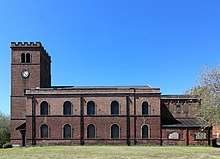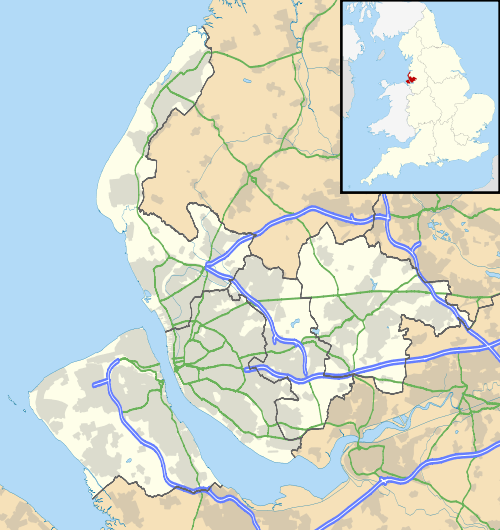Church of St James, Liverpool
St James' Church is an Anglican church in St James Place, Toxteth, Liverpool, England. It is recorded in the National Heritage List for England as a designated Grade II* listed building.[1] Having been declared redundant in 1974, it returned to active use in 2010.[2]
| St James' Church | |
|---|---|
| St James in the City | |
 St James' Church from the southeast | |
 St James' Church Location in Merseyside | |
| OS grid reference | SJ 353 891 |
| Location | St James Place, Toxteth, Liverpool |
| Country | England |
| Denomination | Anglican |
| Website | St James in the City |
| Architecture | |
| Functional status | Active |
| Heritage designation | Grade II* |
| Designated | 19 June 1985 |
| Architect(s) | Cuthbert Bisbrown William Culshaw H. Havelock Sutton |
| Architectural type | Church |
| Style | Georgian |
| Groundbreaking | 1774 |
| Completed | 1900 |
| Specifications | |
| Materials | Brick with stone dressings |
| Administration | |
| Diocese | Liverpool |
| Province | York |
| Clergy | |
| Vicar(s) | Revd Jude Padfield |
| Laity | |
| Parish administrator | Jackie Currie |
History
The church was built in 1774–75 by Cuthbert Bisbrown, who probably also designed it. The timber roof was added in 1846 by William Culshaw.[3] The chancel, designed by H. Havelock Sutton, was built in 1900.[1] On 1 October 1974 the church was declared redundant, and on 9 June 1976 was vested in the Churches Conservation Trust.[4] In May 2010 the church was returned to the Liverpool Diocese, and was re-opened as the Church of St James in the City. As it was in a "semi-derelict condition", a marquee was erected within the church to allow the resumption of worship. Meanwhile, repairs are being undertaken to secure the maintenance of the church's structure.[2] It is intended that the building should be used, in addition for worship, as a 600-seater auditorium and an exhibition centre.[5]
Architecture
Exterior
St James is constructed in red brick with stone dressings. Its plan consists of a five-bay nave, a chancel, and a west tower. Along the sides of the nave are two tiers of round-headed windows. The tower is in four stages with an embattled parapet. Its third stage contains clock faces, and in the top stage are paired louvred bell openings.[1]
Interior
The architectural style of the interior is "conventionally Georgian".[3] There are galleries on three sides, carried on slim quatrefoil cast iron columns. The columns are the earliest existing examples in Liverpool of cast iron columns, and are one of the earliest examples of them in England.[1] The timber roof is open, with Norman-style arches. The east window is stained glass designed by Henry Holiday, dated 1881. There are monuments dating from the late-18th and the early-19th centuries.[3] Many of the monuments relate to the slave trade.[2]
 Restored roof, 2017
Restored roof, 2017 Memorial plaque to Henry Percy Clarke of the King's Liverpool Regiment, killed in World War I
Memorial plaque to Henry Percy Clarke of the King's Liverpool Regiment, killed in World War I Towards the east window
Towards the east window Grade II listed walls, gates and railings
Grade II listed walls, gates and railings
References
| Wikimedia Commons has media related to Church of St James, Liverpool. |
- Historic England, "Church of St James, Liverpool (1209882)", National Heritage List for England, retrieved 6 December 2011
- Building Project, Church of St James in the City, Liverpool, archived from the original on 26 April 2012, retrieved 6 December 2011
- Pollard, Richard; Pevsner, Nikolaus (2006), Lancashire: Liverpool and the South-West, The Buildings of England, New Haven and London: Yale University Press, p. 470, ISBN 0-300-10910-5
- Diocese of Liverpool: All Schemes (PDF), Church Commissioners/Statistics, Church of England, 2011, p. 4, retrieved 6 December 2011
- Newsletter, Friends of Friendless Churches, Autumn 2011, p. 27